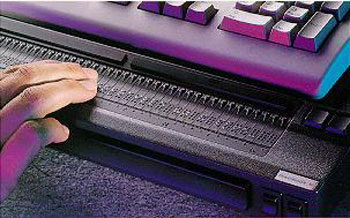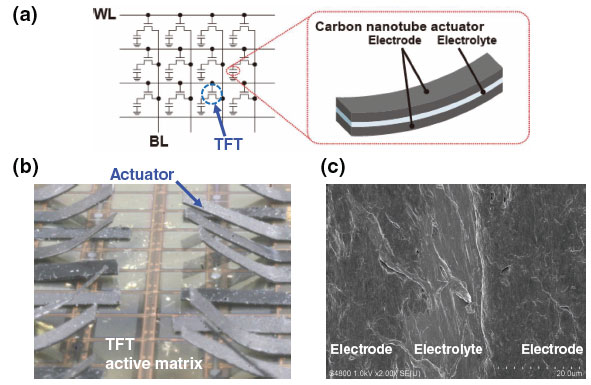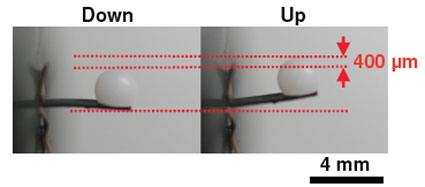| If you are a blind computer user you have to rely on electronic Braille displays which typically allow you to see only one line at a time, no matter what you were doing. Such a Braille display is a tactile, electro-mechanical device for displaying Braille characters, consisting of a row of special 'soft' cells. A soft cell has 6 or 8 pins made of metal or nylon; pins are controlled electronically to move up and down to display characters as they appear on the computer display. A number of cells are placed next to each other to form a soft or refreshable braille line. As the little pins of each cell pop up and down they form a line of braille text that can be read by touch. | |
 | |
| A refreshable Braille display. | |
| In order to develop a more functional, and affordable, tool that would allow the blind to interface with their computers, scientists are working to develop sheet-type, refreshable Braille displays. A group of researchers in Japan has previously reported such full-page Braille displays by integrating organic thin-film transistors (TFT) and soft polymer actuators (see paper in IEEE Transactions on Electron Devices:"Large-Area Flexible Ultrasonic Imaging System With an Organic Transistor Active Matrix"). However, these displays required a large operation voltage – more than 40 V for driving polymer actuators using gold-plated Nafion – and their actuation time of more than 1 second for operating one actuator was too slow for a practical device. The most difficult obstacle for practical applications, though, was the device's instability in ambient conditions. | |
| In their latest work, the interdisciplinary research group from the University of Tokyo, Hiroshima University, Max Planck Institute for Solid State Research, AIST, and RIKEN, have fabricated a Braille sheet display operating at 4 V by integrating organic TFT drivers, organic static random-access memory (SRAM), and carbon nanotube-based actuators. | |
| The team reported their work in a recent issue of Advanced Functional Materials ("A 4 V Operation, Flexible Braille Display Using Organic Transistors, Carbon Nanotube Actuators, and Organic Static Random-Access Memory"). | |
| For a display composed of 144 Braille dots (12 × 12 array), the time to change all Braille dots is 2.91 seconds because all 144 Braille dots are actuated simultaneously once the data are written into the SRAM array. | |
 | |
| CNT-based actuators: a) Circuit diagrams of CNT-based actuators with organic TFTs operating at low voltages. b) Photograph of the CNT-based actuators operated by the organic TFTs. Each actuator is operated by the organic TFT cell below the actuator sheet. c) Cross-sectional scanning electron microscopy image of the CNT-based actuator. (Reprinted with permission from Wiley-VCH Verlag) | |
| The Braille actuators consist of an electrolyte layer sandwiched between two CNT electrode layers. Each CNT-based actuator can be operated selectively using the organic TFT matrix. The actuator sheet is integrated on the organic TFT matrix sheet. | |
| The researchers point out that there are significant relations between the displacement or operating speed and the thickness of the actuator. For example, thinner actuator results in a faster speed and larger displacement | |
| The Braille display fabricated by the team consists of three functional sheets: CNT-based actuators, organic TFTs for driving CNT actuators, and organic TFT-based SRAM. The sheets are laminated to one another using an anisotropic conductive sheet. Since all materials, except from the metal electrodes, are made of organic materials, the entire system is very thin, lightweight, and mechanically flexible. | |
 | |
| Photograph of the actuator with a white Braille dot in the two static states (up and down). (Reprinted with permission from Wiley-VCH Verlag) | |
| "In principle, the Braille display may be realized using an alternative memory concept, such as charge-trap memory or dynamic random access memory (DRAM)," say the authors. "The main drawback of organic charge-trap memories is that they usually require either a large programming voltage or a long programming time. The main problem with organic DRAM is that the rate at which the charge leaks away from the capacitor would be higher than the maximum possible refresh rate. Therefore, organic SRAM is a unique solution to achieve fast programming speeds and low programming voltages simultaneously." | |
| A typical drawback of SRAM is the relatively large area requirement, due to the large number of devices per memory cell. However, unlike in silicon technology, where real estate is very expensive, the integration density in flexible large-area electronics applications is much smaller, so that the large area of SRAM is not really a drawback here. | |
| By Michael Berger. Copyright © Nanowerk Fonte: NanoWerk Spotlight |
